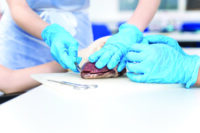Introduction
Egeria densa, also known as Elodea densa because of its previously incorrect classification in the Elodea genus, is the most popular aquatic plant used to teach photosynthesis in the classroom. Originally from Brazil, E. densa has spread to temperate regions on all of the continents except Antarctica. Known for its bright green color and leafy stems, E. densa is an excellent oxygenating plant, making it perfect for use in freshwater aquaria and in the classroom.
Despite its popularity with educators and hobbyists, the use of E. densa is restricted in many states due to its invasive nature. People have improperly disposed of their aquarium plants by introducing them into local freshwater sources. E. densa also easily propagates from stem clippings.
In temperate climates, the spread of E. densa has negatively impacted many aquatic environments. E. densa forms thick beds, and it has impeded the growth of native plants, obstructed fish migration patterns and habitats, restricted water and boat movement, etc. As a result, over 10 states currently have placed shipping and trade restrictions on this species of aquatic plant.
Alternatives to E. densa
Where state laws restrict the availability of E. densa, Carolina offers 2 main alternatives to this popular plant for educators. Elodea canadensis, also known as the waterweed, is very similar to E. densa. Native to most of North America, E. canadensis has very few restrictions on its availability. Although it is not as green and has fewer, smaller leaves than E. densa, E. canadensis is a great substitute when you are performing photosynthesis activities. Like E. densa, its leaves are only 2 cells thick, making the microscopic observation of plant cell structure, chloroplasts, and cytoplasmic streaming simple. You can successfully perform all other common photosynthesis activities using this species of Elodea.
Based on the season and availability, the genus Chara offers another great alternative to E. densa when you are teaching photosynthesis. Although chara looks much like an aquatic plant, it is actually green algae. It belongs to the order Charales, which contains the closest green algal ancestors of modern-day land plants.
Chara is often called stonewort because it grows well in lime-rich waters, which causes hard calcium carbonate deposits to form on the algae. Chara has leaf-like structures (branches) arranged in whorls around a main stem (axis), much like the aquatic plants described above. However, on chara these leaf-like structures are thicker, making microscopic observation more difficult. Oxygen production and CO2 depletion experiments, on the other hand, are very successful when you use plants from the genus Chara in your photosynthesis labs.
If you live in a state that restricts the availability of E. densa, Carolina automatically sends you a suitable replacement that we guarantee will work just as well for your lesson plans!
Activity
Here is a short lab activity to demonstrate the oxygen production of aquatic plants during photosynthesis. This activity works well for any of the plants described above.
Materials
- 8—10 Sprigs of an Aquatic Plant/Algae (E. densa, E. canadensis, or Chara)
- Large, Clear Container
- 1 g Sodium Bicarbonate
- Stirring Rod
- Large Funnel (must fit into the large container upside down)
- Test Tube (must fit inside the stem of the funnel)
- Rubber Band
- 20-W Fluorescent Light Source
- Dechlorinated Tap Water
- Scissors
Demonstration procedure
- Fill the large, clear container 3/4 of the way full with the room-temperature, dechlorinated tap water.
- Add 1 g of sodium bicarbonate to the water and stir until dissolved. This is the CO2 source for the plant that is being used.
- Cut 8 to 12 sprigs of the plant to a length of about 20 cm.
- Place the cut sprigs into the mouth of the funnel.
- Invert the funnel and place it into the container of water, trapping the aquatic plant inside the funnel.
- Make sure the stem of the funnel is completely submerged in the water. If it’s not, add more room temperature, dechlorinated water to the container until the funnel stem is covered.
- Wrap a rubber band about 1/4 of the way down the test tube several times. This allows the test tube to sit inside the stem of the funnel without falling all the way into it.
- Submerge the test tube into the water in the container, filling it completely.
- Invert the test tube in the water and place it over the stem of the funnel while it is still submerged. Make sure no air bubbles are trapped in the test tube.
- Place a fluorescent light source near the container and turn it on.
- Leave this setup undisturbed for 24 hours.
- Observe the oxygen that is trapped in the test tube after 24 hours.
Conclusion
As oxygen is produced through photosynthesis, it travels up the stem of the funnel into the test tube where it displaces the water. This is a simple demonstration that allows your students to observe photosynthesis firsthand. E. densa, E. canadensis, and Chara offer great aquatic organisms to use for this activity. Although your state may limit your accessibility to one of the more well-known aquatic plants, Carolina ensures you have success with any alternative we provide.









